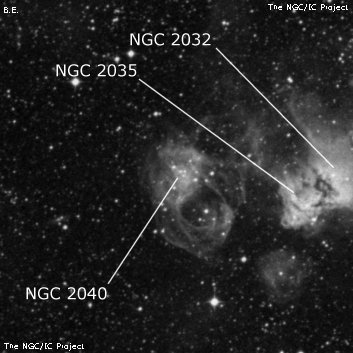
John Herschel discovered NGC 2040 = h2918 on 2 Nov 1834 and recorded "F; irreg R; glbM; r; 2'. (Pl III, fig 5)." On a later sweep he reported "vF; R; follows 3 vB L nebulae [NGC 2030, NGC 2032 and NGC 2035] which run together." His position (from 5 sweeps) is accurate and an excellent sketch of the complex is on plate III, figure 3.
James Dunlop possibly discovered this nebula (D 220) earlier on 27 Sep 1826 and logged "a round faint nebula, about 40" diameter." His position is just 4' NNW of the center of LMC N59B = NGC 2040, but given the range of his positional errors, it's possible this observation either refers to nearby NGC 2032 or 2035 (part of the same complex).
600/800mm - 24" (4/11/08 - Magellan Observatory, Australia): this is a bright, irregularly round glow, ~2' diameter, located ~4' ENE of the Seagull or Dragon's Head Nebula and part of the same emission complex. The nebulosity surrounds a cluster of roughly 15 stars (LH 88). A UHC filter provided an excellent contrast gain at 200x and revealed a very irregular outline. The POSS image shows delicate filaments to the south forming a large loop (SNR shell SNR 0536-67.6) although I don't believe this extension was recorded.
Notes by Steve Gottlieb